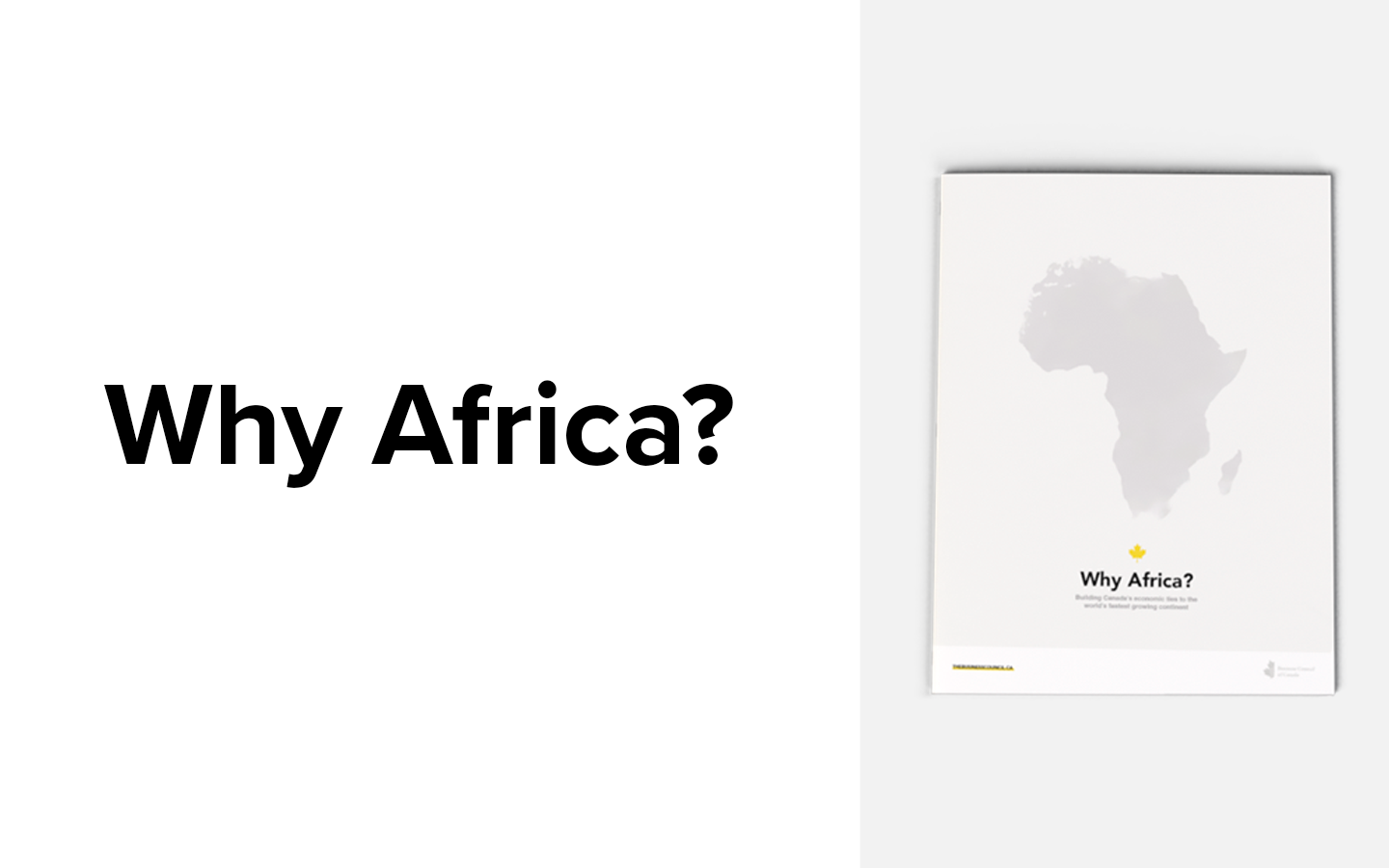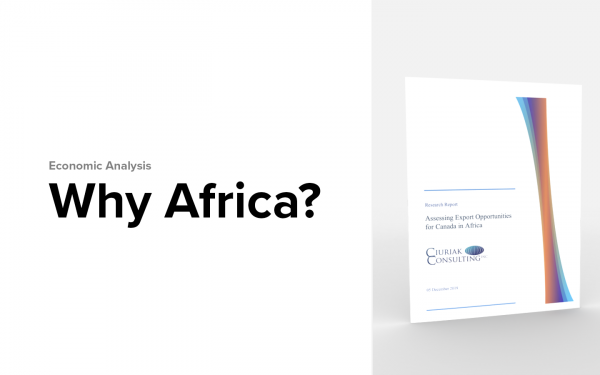Why Africa?
Building Canada’s economic ties to the world’s fastest-growing continent
Introduction
For the past several years, Canada has made trade diversification a key priority. In its 2018 Fall Economic Statement, the federal government committed to making Canada a more globally connected economy by increasing overseas exports by 50 per cent by 2025.1 This is an ambitious goal that will require a comprehensive export strategy focused on high-growth markets where Canada underperforms.
To date, trade diversification discussions have often focused on the Asia-Pacific region given the well-documented rise of Asia’s middle class. While this region must continue to be a focus, Africa deserves attention given its large and under appreciated growth potential. Meeting Canada’s trade diversification target will simply not be possible without an Africa strategy.
The opportunity for Canada in Africa is enormous.
Economic analysis commissioned by the Business Council of Canada suggests that if Canada seized the opportunities in Africa our exports to the region could reach USD 6.6 billion in 2030, representing a growth potential of about USD 4.1 billion over the coming decade.
The objective of this report is not only to highlight the economic potential of Africa, but to clearly identify the most promising opportunities for Canadian businesses.
Why Africa? Understanding the scale of Africa’s growth potential
While growth varies across the continent, Africa is home to six of the top 10 fastest-growing economies in the world. That is not to say that the picture is entirely rosy. In fact, three of Africa’s largest economies – South Africa, Nigeria and Angola – are experiencing serious and unique economic challenges which are depressing continental growth. Despite these challenges, the continent is still growing at a rate of 3.6 per cent. Not only is this rate faster than the global average, but many economists expect Africa’s growth to accelerate in the coming years.2
Africa’s relatively young and fast-growing population should help bolster and sustain growth for the foreseeable future. This is in contrast to many parts of the advanced and developing world which are experiencing or will experience aging populations and shrinking workforces. Africa’s working-age population is projected to expand from 700 million today to one billion by 2030. During the same period, the total population will grow from 1.2 billion to 1.7 billion.3 Fast-growing populations can also present challenges, such as necessitating the creation of enough jobs for workers entering the workforce, but, if well managed, Africa’s large workforce could drive a rapid economic expansion.
As the population grows, so too will the number of middle-class Africans. By 2030, 212 million sub-Saharan Africans will be part of the middle class, an 86 per cent increase from 2015.4 The McKinsey Global Institute forecasts that household consumption will grow from USD 1.4 trillion in 2015 to USD two trillion in 2025. While a large share of this total consumption will come from the most affluent households (USD 50,000 in annual income), many Africans will become emerging consumers or global consumers, earning between USD 5,000 and 50,000 per year. These consumers are able to spend beyond their basic needs.5
By 2030, 212 million sub-Saharan Africans will be part of the middle class, an 86 per cent increase from 2015.
For this development to be possible, it is expected that more Africans will move to the cities where jobs are more plentiful, productive and better paying. Nearly 200 million new urban residents are anticipated by 2025. At that time, Africa is expected to be the world’s fastest-urbanizing region, and by 2045 it will have a larger urban population than China or India. The rate and scale of urbanization will be transformative and could make African consumers more connected to the global market.
African workers and consumers have been slower than in other parts of the world to obtain access to the internet and smartphones, but there have been significant gains in recent years. According to data from GSMA Intelligence, there will be significant growth in internet and smartphone usage by 2025. The number of connected smartphones is projected to increase from 250 million in 2017 to 690 million in 2025.6 Better access to the internet will allow these users to take advantage of e-commerce platforms for goods and services.
The recent ratification of the African Continental Free Trade Agreement (AfCFTA) was a historic moment for the continent. The agreement will bring 1.3 billion people into an integrated common market, creating the world’s largest free trade area by number of countries. When fully implemented, AfCFTA has the potential to boost intra-African trade and integration. Intra-Africa trade has been historically low with intra-African exports totaling 16.6 per cent of total exports in 2017, compared with 68 per cent in Europe, 59 per cent in Asia and 55 per cent in the Americas.7
If successfully implemented, AfCFTA has the potential to both boost intra-African trade and make it easier for exporters to access the African market. This can only be achieved with significant new investments in regional infrastructure, the establishment of a common external tariff, deeper economic harmonization and the entry into formal cross-border trade by thousands of African companies that will become prospective partners for international suppliers of production inputs and business services.
Canada’s trade performance in Africa, 2001-2018
The Business Council of Canada commissioned Ciuriak Consulting to analyze Canada’s trade performance with Africa and identify potential areas for greater collaboration (Annex 1). The study finds that while African growth has accelerated substantially, Canada is falling behind compared to other competitors in the market.
Steady growth over the past two decades has resulted in the economy of Sub-Saharan Africa (SSA) approaching USD 4.8 trillion in terms of purchasing power parity. When adding the Maghreb economies of North Africa, this figure rises to USD $7.5 trillion, larger than the Japanese economy.
Not surprisingly, this growth has attracted the attention of the world’s largest economies:
- The European Union has negotiated Economic Partnership Agreements with African countries;
- China is heavily invested in the region through its Belt and Road Initiative;
- The United States has the Prosper Africa project, which is a reaction to the expansion of China’s relationship with Africa;
- In October 2019, Russia organized a summit with African leaders in Sochi.
The heightened interest in Africa reflects both strategic and commercial factors. The commercial interests are substantial. Between 2001 and 2018, the absolute value of growth of goods exports by the major economies to Africa amounted to USD 250 billion.
During this period, Canada more than tripled its exports to Africa from USD 1 billion in 2001 to USD 3.3 billion in 2018. However, Canada captured less than one per cent of the additional global exports to Africa that were realized in this period. Canada has already missed out on significant export growth opportunities and risks being further shunted aside in an increasingly important global market, absent a strategy to sustain and expand its current small foothold.
As outlined in Table One, Canada’s commercial engagement with Africa increased over the past two decades, and compared favourably to the US and EU in relative terms. The share of Canada’s merchandise imports sourced from Africa grew between 2001 and 2018, and the share of Canada’s worldwide exports going to Africa almost doubled.
However, the EU and China are far ahead of other economies in scale. In terms of growth, while Canada more than tripled its exports to Africa over the period (from USD 1 billion to USD 3.3 billion), India expanded its exports to Africa almost 10-fold (from USD 2.8 billion to USD 27 billion) and China more than 17-fold (from USD 6 billion to USD 105 billion), while the EU led in absolute terms with an expansion of exports of over USD 115 billion.
Using a gravity model, which considers Canada’s export pattern globally based on the size of partner economies, their distance from Canada and the relative ease of doing business in those markets, Canada is underperforming compared to our competitors, particularly in the fastest-growing markets. Based on the model, it is possible to establish a predicted level of Canadian exports by market and to compare this level to the observed level. If predicted levels are higher than actual, this may indicate that Canada has underdeveloped export potential.
Table Two illustrates the top 10 markets in each of the three categories of exports in which Canada performs strongly.
Canada performs particularly well in niche markets where it is a global export leader. For example, agri-food exports to several African destinations (especially Algeria, Morocco and Ghana) are well above expected levels due to strong sustained wheat sales. However, these exports have not scaled over time as they reflect population trends and structural domestic production gaps in the destination economies, rather than growing Canadian export capabilities.
Canada has also had success exporting manufactured goods to some African markets. Ghana tops the list, importing about USD 31 million (or 55 per cent) more from Canada than would be expected. This reflects a relatively varied mix of products, ranging from automotive to machinery and equipment, as well as smaller quantities in a range of other products. In Ethiopia, Canada exports about USD 21 million more than would be anticipated, boosted by significant amounts of aerospace products, likely reflecting Ethiopian Airlines’ role as one of Africa’s main carriers and Addis Ababa as a major transportation hub. Additionally, Canada does well in manufactured goods exports to Burkina Faso due to the fact that Canada is the largest investor in that country’s mining sector.
Table Three shows the most under-traded markets in each of the three categories of Canadian goods exports. Nigeria, South Africa and Egypt stand out as markets where Canada would be expected to be exporting much more. Exports to Nigeria are less than half the predicted amount of almost USD 700 million. To South Africa, exports are one-third lower than the predicted USD 460 million. And to Egypt, they are 40 per cent below the expected USD 328 million.
For a select group of 12 high-growth economies, which are projected by the IMF to average 9.3 per cent annual growth in US dollar terms over the period 2020-2024, Canada’s exports to these countries are on average more than 40 per cent below what might be expected for a total shortfall of almost USD $780 million.
For the 10 major under-traded markets, the shortfall in Canadian exports is about USD 900 million or roughly half of what would be expected. The lion’s share of the shortfall is due to missing manufactured goods exports. Canada’s actual manufactured goods exports to these 10 markets of about USD 650 million is less than half the expected USD 1.4 billion. Agri-food exports also fall well short of expected levels (42 per cent).
For a select group of 12 high-growth economies, which are projected by the IMF to average 9.3 per cent annual growth in US dollar terms over the period 2020-2024, Canada’s exports to these countries are on average more than 40 per cent below what might be expected for a total shortfall of almost USD 780 million. Given the rapid growth of these economies, especially in terms of their international purchasing power, our underdeveloped market presence leaves Canada poorly positioned to capture these significant new growth and diversification opportunities.
Opportunities for Canadian businesses in Africa
By neglecting its economic relationship with Africa, Canada is missing a significant opportunity to grow its trade. Most disconcerting of all, the country is currently under-performing substantially in its traditional areas of strength. This does not bode well for Canada’s future relationship with Africa — one of the world’s most promising emerging markets.
Ciuriak Consulting extends the above analysis by estimating Canada’s export growth potential to Africa in 2025 and 2030. The combination of strong economic growth and the expansion of trade in the region due to the AfCFTA, new trade infrastructure and the rapid spread of ecommerce, create significant opportunities for Canadian businesses.
For the top 10 under-traded economies in 2025, compared to the current levels of trade, potential export growth amounts to USD 2.5 billion, including almost USD 1.9 billion in manufactured goods exports.
For all African economies, Canada’s exports to the region could reach USD 5.3 billion in 2025. This represents a growth potential of about USD 2.8 billion over the coming half-decade.
Repeating this exercise for 2030, Ciuriak Consulting finds that for the top ten under-traded economies, compared to current levels of trade, the potential export growth amounts to USD 3.5 billion, including almost USD 2.6 billion in manufactured goods exports.
For all African economies combined, Canada’s exports to the region could reach USD 6.6 billion in 2030. This is a growth potential of about USD 4.1 billion over the coming half-decade.
Recommendations for business and government to seize the opportunities
Canada needs a comprehensive Africa strategy. The opportunities in Africa are simply too large to ignore. Greater commercial engagement alone will not suffice. Coordinated actions from government and business will be required if Canada is to play a more significant role in the development of Africa.
Recommendations for government:
- Develop an Africa strategy – Canada has spent more than five decades working with African countries and regional bodies to provide development assistance, promote democracy and increase commercial and economic ties. Our contributions in areas ranging from gender equality to peacekeeping and public health over the last several decades means that Canada has earned a high-level of trust in many African countries. What is missing is a coordinated approach with stakeholders to develop and execute a common economic and development strategy.
- Prioritize high-level visits to African countries – High-level visits to Africa are usually an afterthought for Canadian business and political leaders. Meanwhile, China’s top-level leadership has made 79 trips to 43 African countries from 2007 to 20178. Prior to his visit in February of 2020, Prime Minister Trudeau had visited only three African countries (Liberia, Mali and Madagascar) since 2015. Consistent, high-level engagement is critical if Canada is to develop a serious Africa strategy.
- Ensure the success of AfCFTA – AfCFTA holds great potential if successfully implemented and expanded. AfCFTA countries should strive to establish a continental customs union and evolve into a unified single African market, consolidating regional FTAs negotiated on a bilateral basis. Canada has played an important role providing technical assistance to AfCFTA. Given this history and our trade negotiation expertise, we should continue to offer technical support to help AfCFTA reach its full potential. This has the added benefit of positioning Canada to be first in line to negotiate a trade agreement with AfCFTA should a customs union be realized.
- Negotiate foreign investment protection and promotion agreements with AfCFTA members – As outlined above, negotiating a free trade agreement with AfCFTA bloc will not be possible in the near term. As an alternative, Canada should seek to negotiate foreign investment protection and promotion agreements with as many AfCFTA members as possible. This will have an immediate and positive impact on trade and investment while positioning Canada to negotiate a more comprehensive trade agreement with the AfCFTA when possible.
Businesses also have to step up if Canada is to unlock the opportunities in Africa.
Recommendations for business:
- Identify niche market opportunities – This report identifies markets in Africa where Canadian exporters could see the greatest growth potential. These markets represent extraordinary opportunities for Canadian firms to grow their presence. Given the lack of regional integration, the best approach is to target specific countries or regions first and expand from there.
- Invest in local representation – Businesses that identify opportunities in African countries should invest in local representation to fully understand the long-term opportunities and challenges in Africa. The complexities of the region require consistent engagement to adequately manage risks and take advantage of opportunities.
- Develop African talent – Investing in local talent is key to succeeding in Africa. According to recent research by McKinsey, successful companies in Africa take an active approach to talent.9 This includes investing in training programs for existing talent, offering internships and apprenticeship programs and partnering with local universities to connect with potential recruits.
- Proactively manage risk – Companies that aspire to do well in Africa must successfully navigate corruption and macroeconomic instability9. This requires a proactive approach to risk management that includes having local representation, developing of robust risk-monitoring functions and establishing contingency plans for everything from political instability to supply interruptions and infrastructure failures.
- Think long-term – Africa’s rise will not be linear and will vary significantly from country to country. As a result, its critical that companies develop long-term plans for Africa and commit to the market for at least a decade.












